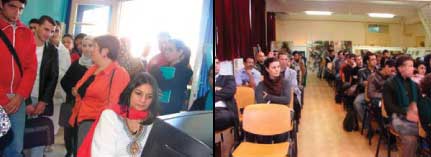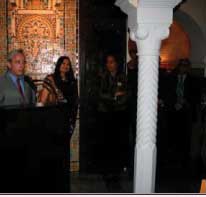Nasreen Haroon in Algeria
By Nika Cavat

Left: Nasreen Haroon analyses her work for the benefit of students of Ecole Superieure
Des Beaux Arts. Right: Attendees at Nasreen’s
presentation at Ecole Superieure Des Beaux Arts
The man, clothed simply in a white tunic and turban, lies prone with his legs tucked under him, his forehead touching the ground. His figure is dead center of the canvas against a cornflower and maize pattern, which moves in diagonal lines like the pulses on a music monitor all around him. Pakistani-American painter, Nasreen Haroon has titled her ART in Embassies painting, “Surrender,” and for good reason.
The man’s body attitude is one of a complete yielding to God. It radiates a simple grace and beauty and is one of four paintings that made the long trip halfway around the world to the US Embassy in Algiers, Algeria.
Painter Haroon grew up in Karachi, Pakistan, and moved with her family to Southern California in 1980. It was there she began what has evolved into a lifelong rendering of her spiritual values and nature, the sandy beaches and stately palms of her original home in Pakistan and those of her adopted home of California. Images of Mecca and devout Muslims in prayer also feature prominently in her figurative work. One of her paintings, “Reading”, graces the cover of the US Embassy in Algiers’ brochure. Rendered in tawny, saffron and buttery white oil paint, a diminutive man sits immersed in reading before two majestic windows.
An ebony-haired woman with a regal, but unassuming demeanor, Haroon takes great pride not only in the art itself, but also in how it brings people of diverse religious and cultural backgrounds together. She is a valued member of the ART in Embassies Program, established by the United States Department of State in 1964 to put art in embassies around the world as a means of encouraging peace and dissolving barriers between peoples. The Program boasts such artists as Willem De Kooning, Jackson Pollack, and Roy Lichtenstein. In addition to sharing the common language of art between countries, exhibits like Haroon’s, according to the Program’s literature, “play an important role in our nation’s public diplomacy.”
 US Ambassador David Pearce speaks at a reception he hosted
US Ambassador David Pearce speaks at a reception he hosted
in honor of Nasreen Haroon (second from left) |
The artist recently returned from a weeklong trip to Algiers. Her daughter, Sana, accompanied her on this journey. There, Haroon participated in cross-cultural exchanges with children of the SOS Femmes en Destresse, a battered women’s shelter. She explained that collaborating on a massive beach mural works as a kind of healing therapy. At the Bentalha Center, run by a group called FOREM, Haroon taught a class for children, many of who witnessed their parents’ deaths during a terrorist attack in Bentalha, a small town outside of Algiers. In 1997, there was a one-night massacre of approximately 200 people. FOREM, a Non-Governmental Organization, (NGO), was founded to provide mental and physical support for people in need. Haroon also held master classes at the Ecole Superieure des Beaux Arts for art students. At a US Embassy reception for Haroon, Ambassador David Pearce commented on how her art seeks to transcend “boundaries, languages, and religions to find a common language,” the language of creativity and of the human imagination.
Haroon’s paintings have been shown in American embassies in Islamabad, Pakistan; Dakar, Senegal; Abu Dhabi, UAE; and Nigeria. She was also appointed cultural envoy to the UAE in 2007. If the very best of religion raises people to their most altruistic selves, then art serves as the other great spiritual guide. Her interfaith work began in 1991 after the first Gulf War and then picked up in earnest after the terrorist attacks in 2001, when she engaged full-time in lectures and discussions in churches, mosques, educational institutions, and on television.
The artist’s eagerness to pursue this mission has occasionally meant dealing with dangerous situations. The Regional Security Office of the US Embassy states in a security brief that Al-Qaeda in the Lands of the Islamic Maghreb (AQIM) continues its terrorist activities in Algeria. In 2007, the AQIM was responsible for nine confirmed suicide bombings, two of which were in Algiers. Authorities discouraged foreign visitors from any unnecessary or unplanned traveling, and warned about a high level of crime throughout the city. Nevertheless, Haroon spent almost every waking moment visiting art students, dignitaries, artists, and political figures.
The week was meticulously planned to maximize Haroon’s position as a cultural envoy, not only to expose her work to Algerian artists, dignitaries, and students, but to allow her to gain a deep and full appreciation for the breadth of Algerian art and culture. Included in the activities was a presentation of her paintings at the Musee des Beaux Arts, where sixty Algerian artists and other museum staff attended to hear Haroon speak. She then discussed her work at Galarie d’Art Benyaa. Monsieur Farid Benyaa, a prominent artist and gallery owner, enthusiastically introduced Haroon, describing for the audience the evolution of her art. The gallery was filled to capacity with Algerian artists, actors, writers, and media.
Haroon was given tours of such historic landmarks as the Monument of Martyrs. “Everyone was so nice. Bonjour Algerie, a live television show, interviewed me for what I thought would be five to ten minutes,” Haroon mentioned, “but surprisingly it went on for half an hour and then on the last day, I was interviewed with my daughter, Sana, which the Algerian satellite TV channel, Canal Algerie, broadcast on the evening news.” At a juncture in world history where misperceptions – cultural, religious, or otherwise - about people is cause for waging war against them, the art Nasreen Haroon helps to counteract this violent impulse and turn it into positive creativity.
Haroon has a show opening December 13-January 7, 2009, at the Schomburg Gallery, 2525 Michigan Ave. E3A, Bergamot Station Arts Center, 310/453-5757, in Santa Monica, California. The opening reception is on December 13 from 3 – 5 pm. Further information about her work can be found at www.nasreenharoon.com.
(Nika Cavat is a free-lance writer specializing in art, politics, and academia. She can be reached at nikawriter@yahoo.com)
-------------------------------------------------------------------------------------

